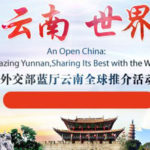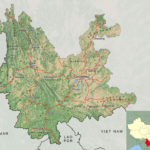The Yunnan Provincial Museum which was opened on 18 May is a magnificent building which is specifically designed to house and display in a unique setting the province’s rare and ancient cultural artefacts.
The facade of the museum building is very impressive
The beautiful exhibits provide visitors with a coherent narrative and context connecting the artefacts with the history and culture of the many distinct communities in the province and their relationship with each other.
As you will see, this Museum is much more than the usual random collection of objects and for this reason is a significant addition to the Kunming’s reputation as the principal venue for cultural exchange between Yunnan and the rest of the world.
Construction of the museum commenced in June 2009 and was completed in December 2014. It covers 10 hectares with the building itself taking up 6 hectares, and is five times bigger than the old museum based in downtown Kunming.
The displays and exhibits provide an insight into the history of Yunnan Province, from prehistory to 1949 when the People’s Republic of China was founded. The cultural artefacts on display highlight the development of the civilisation created by the multiple nationalities which make up the population of Yunnan province and provides visitors to Kunming (Yunnan) with a deep understanding of Yunnan’s natural resources, geography, history, art, culture, and its ancient technological expertise.
The museum is a state of the art public building with modern structure with a functional layout incorporating modern energy-saving, environment-friendly and smart guide technology.
The museum consists of six basic exhibitions and four theme exhibitions. It is worth mentioning that the theme exhibitions and temporary exhibitions include more than 10,000 items including porcelains, ancient paintings and contemporary artworks among which are many rare and priceless items on display for the first time.
The Six Basic Exhibitions
Yunnan in Prehistoric Era
This exhibition is based on major geographical discoveries and historic sites and highlights the importance of Yunnan in relation to the world during the prehistoric era with particular regard to production and the way of life, religious art and cultural difference of the different communities living in different parts of Yunnan at that time.
Yunnan in Bronze Era
This exhibition is based on the Historical Records of the West Han Dynasty (206 BC-23) and displays comprehensive and representative selection bronze artefacts from Yunnan’s bronze culture.
Yunnan in the Period from the East Han Dynasty (25-220) to Wei (220-265) and Jin (265-420) Dynasties
The theme of this exhibition is interaction between the Han culture and Yunnan’s ethnic culture, with particular reference to the remarkably close links between Yunnan and Central China from ancient times which is a surprise given Yunnan’s remoteness in the far and inaccessible southwest.
Yunnan in Tang and Sing Dynasties
During the Tang (618-907) and Song (960-1279) dynasties, Yunnan was known over a period of 600 years as the kingdoms of Nanzhao (738-937) and Dali (938-1253). This exhibition respectively explores the background and establishment of the Nanzhao Kingdom with displays of the Kingdom’s artefacts. The exhibition for the Dali Kingdom includes an introduction to its history, society, architecture, ethnic costumes, folk customs and Buddhist culture. The exhibition provides a remarkable insight into the cultural features of the two ancient Kingdoms.
Yunnan in the Yuan, Ming and Qing Dynasties
Yuan (1253-1368), Ming (1368-1644) and Qing (1644-1911) are the three most important dynasties in the history of the social and economic evolution and development of Yunnan Province as during this period the Han, Mongolian and Man people immigrated into Yunnan in large numbers resulting in the integration of the many nationalities of Yunnan.
This exhibition explores the origins of the different nationalities in Yunnan and showcases the evolution of their ethnic cultures over the period and with the artefacts on display demonstrates the interaction and amalgamation of Yunnan native ethnic groups with the Han culture.
Yunnan in Modern Times

This exhibition is dedicated to historical events in Yunnan, including the Chongjiu Uprising (1911), Nation Protection Movement or Anti Yuan Shikai Movement (1915), the Japanese Invasion, and the December 1 Movement (1945), etc. These events suggest that Yunnan played a significant or perhaps a primary role in the anti-feudalism, anti-imperialism, and democracy and peace movements in modern Chinese history.
The Four Theme Exhibitions
Porcelains and Potteries

Since its establishment 60 year ago, Yunnan Provincial Museum has expanded its collection of ancient porcelain artefacts from all over the province. So far, the collection numbers over 4,000 items. The museum’s collection is the largest in Yunnan especially in terms of variety, quality and the quality of its research.
Exhibition of Paintings by Ms Liu Ziming
Ms Liu Ziming (1927-2014), member of China Artists Association, was born in Yanjing County of Zhaotong Prefecture in the northeast of Yunnan. She is a master of oil painting.
Exhibition of Rare and Precious Paintings

This theme exhibition houses painting works created in the dynasties of Song (960-1279), Yuan (1253-1368), Ming (1368-1644) and Qing (1644-1911), and the modern times. On display are about 70 exquisite works from different periods, offering a distinctive feeling of the evolution of Yunnan’s history.
Exhibition of Ancient Golden Artefacts in China

Based on the time order of Chinese history, exhibits in this theme exhibition hall include golden artefacts unearthed. Plus, the exhibition of the silvery and golden wares unearthed from the Dai ethnic Chieftain Tao’s Tomb in Jingdong County of Pu’er Prefecture in the south of Yunnan adds much glamour.
Instructions for Visitors
Address: 6393, Guangfu Rd, Kunming (near the Guandu Old Town)
Tel: 0871-6728 6863
1. Opening hours
09:00-16:30
Tuesday to Sunday (except public holidays)
2. Admission is free, but visitors must get visiting tickets via registering valid documents.
3. The daily number limit of visitors to the museum is 3,000.
4. Groups who intend to get visiting tickets in advance must reserve (0871-6728 6863).
5. Transport
Public bus No.: K15, 165, 169, 174, 253, 255, A12, D7, stop at Guandu Ancient Town, then walk about 500 metres



